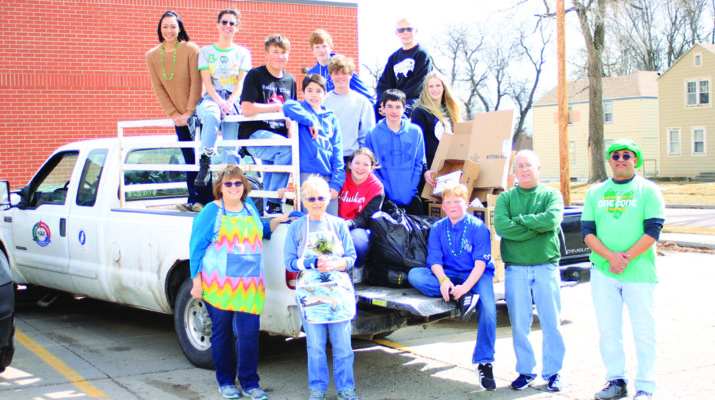Fourteen doors: a few proclaim “milk jugs”, more invite “Plastics #1-7”. Wait . . . the bottom of the jug has a No. 2, and other containers appear to be the same type of plastic – where do they go?
At Keep Alliance Beautiful, “milk jugs” is our catch-all term for any container made from High Density Polyethylene (HDPE), which is naturally translucent. Other colored plastic labeled No. 2 started off in this form before being colored to suit the company’s product. So, the milk jug spots on our long trailer at Second Street and Cheyenne Avenue are meant for any of the sort-of-see-through No. 2’s.
Some area recycling facilities do not accept No. 1-7 plastic. If so, separating milk jugs may not be part of the sorting process in their opinion. We make the effort at KAB because this type of plastic is (currently) worth more per pound than anything else exiting the balers.
I challenge milk drinkers to lug your jugs to 107 ½ Cheyenne Ave. That undyed plastic tipped the scales at 9,341 pounds in 2021, more than the previous two years combined! Since trailer space fills up fast, feel free to stop by the front door between 8 a.m. and 3 p.m. weekdays.
Anyone who does drop something off may notice the white bales that will soon be stored to the south. We bale and store milk jugs until there is enough for a trailer load. The plastic leaves for central Nebraska at least once a year to become 4 x 8-foot sheets sold to the construction industry.
Jim Weber has been operating Sand Hill Plastics at Kearney for three decades. Although four and a half tons of milk jugs seems like a lot to me, at 20 gaylord boxes per bale, what we sell him in a year is processed in less than a day. “We keep 12-15 truckloads of product in the warehouse so I don’t run short,” he said. Sand Hills maintains a production of 4 million pounds processed a year.
Sorting milk jugs is easier on the nose this time of year before the heat returns. Whether recyclers rinse the rest of their plastic more thoroughly is a moot point because summer always comes with a sour scent at the recycling center. Weber described how a little leftover milk or dirt comes out in the manufacturing process.
First, workers load bales into a large shredder then a grinder produces chips to the size of fingernails. Next, the washline employs extreme agitation and cold water. The float/sink tank separates anything other than HDPE. Weber explained the desired plastic has a specific gravity of less than 1 (.95 or .96) compared to other plastics and materials registering more than 1 that made the trip, such as No. 1 (PET) plastic bottles. Drying follows to produce “clean flake”. “The extruder melts it and we can shape it into a sheet,” he said.
Weber explained he only uses HDPE because it is “one of the most abundant plastics we make and easiest to shape into new products.”
Sand Hill sources materials from multiple providers, buying by the truckload primarily in the Midwest though the company goes as far as Texas and Pennsylvania when necessary.
Weber said they sell direct to the end user via their website as well to contractors, builders and resellers. Although the sheets (½ to 1/16-inch) come in the same size as plywood, “Plastic is a whole different animal,” he said of the materials’ applications. Plastic stands up better to water, animals don’t chew it, insects can’t climb it and the material is always the same color, he said.
Concerning economics, Weber said the price for recycled plastic follows supply and demand. Higher oil prices to produce virgin plastic, for example, make recycled material more attractive. This is currently the case though because people have recycled more during the pandemic there is a short-term glut holding the price steady, he added.
“I see recycling these plastics as an ongoing venture for a long time to come,” Weber said. “. . . We need to figure out how to deal with (them) after we’re done. . . . In reality I think we need to process our waste rather than bury it.”

